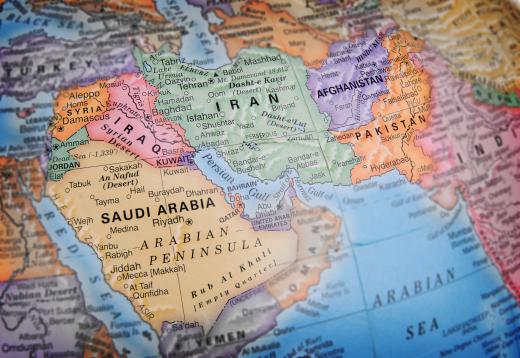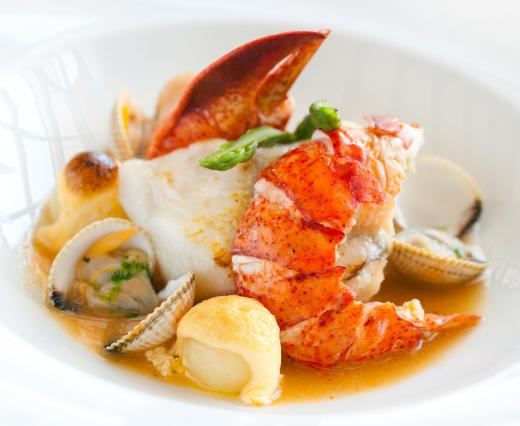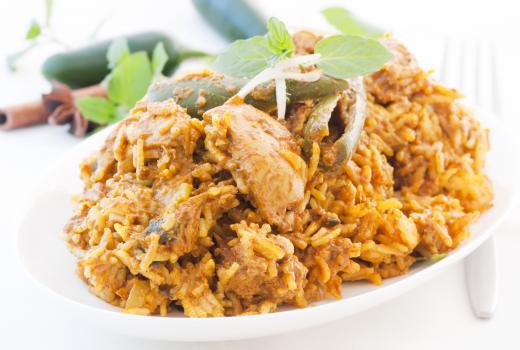Saffron is the dried stigma (tiny threadlike strands) of the Crocus Sativus Linneaus, also called the fall flowering or saffron crocus, a member of the iris family. It is the world's most expensive spice by weight, but very little is needed to flavor and color food. This spice has a strong earthy, hay-like flavor and gives paella, biryani, and other dishes their yellow-orange color.
Culinary Uses

Fortunately, a very little of this spice goes a long way — just few threads can flavor and color an entire dish. Experts often recommend soaking the strands in very hot milk or water before using them to help release the bright, rich yellow tones and distinctive flavor. Saffron is said to taste sweet and earthy, with scents of hay and honey. Cooks shouldn't use more than is called for in a recipe because too much can give food a medicinal taste. The flavor can soak into wood, so it's best to avoid wooden spoons or other utensils when making dishes with this spice.
Saffron is most often used in dishes from South Asia, parts of Europe, and the Middle East. It is considered essential for French bouillabaisse. The spice is often used to flavor and color rice dishes, stews, and fish, among other foods.
Substitutes

With saffron being so expensive, other spices are often substituted for it, especially in pre-packaged mixes. Most commercial rice mixes, for example, actually use turmeric as a substitute, which dyes the rice the distinctive yellow but does not give the same flavor. Safflower, marigold blossoms, or annato can also be used to provide a similar yellow-tone to foods.
Medicinal Uses

Saffron is widely used in Ayurvedic medicine, India's traditional system of health that relies on natural products, prevention, and balance. It is used in remedies for everything from arthritis and asthma to infertility and impotence. Ancient Egyptians used the spice to treat kidney problems, and there are now research results that might suggest that one of its ingredients may help lower high cholesterol. There are even suggestions that this spice may have been used against cancer in the Middle Ages, although with what success is unknown.
Types and Storage

Although the thin threads are probably the best known version of this spice, it's also available in powdered form. Most professional cooks do not recommend buying it when it has already been powered because of the possibility that it has been combined with turmeric or another less expensive substance. The powdered spice also loses its flavor more quickly than whole stigmas.

Cooks can recognize good quality threads because they are bright red and have a good smell. The darker the red, the higher the quality of spice, in most cases. The tips should be a slightly lighter shade, which indicates that they are natural and have not been dyed to look darker. Some threads include a small amount of yellow, which typically means that they are not as strong.

Saffron is very sensitive to heat and light, so should be stored in a cool, dark location. It's also important to keep it dry, as high humidity can cause it to smell musty and make it age faster. The threads can also pick up the flavors of other spices; storage jars should be very clean, with no trace of anything else that could ruin the taste. When stored properly, this spice can last for several years.
Production

A flower's stigma is the female reproductive organ. It accepts the pollen that is produced by the stamen, which becomes the seeds of the next generation. Each stigma is very small and, in the saffron crocus, there are usually only three per flower. Tens of thousands of individual red strands go into a single ounce of the spice, and the stigmas must be hand-plucked from the flowers. The combination of its rarity and labor intensive production helps explain why this spice is so expensive to produce.

Saffron originated in the Middle East, but its use spread throughout the ancient world. Most is grown in Iran and Spain, but Greece, Afghanistan, and the Kashmir region. It grows well in a Mediterranean climate, and does best with wet springs and hot, dry summers.
Other Uses
Aside from its use in food and medicine, this spice has also been used to dye cloth and make perfume. Historically, it was also used to color women's hair and skin, and even to scent bathwater.

"Donning the saffron robes" is a poetic way of saying "becoming a Buddhist monk." The followers of the Buddha selected this shade of yellow as the official color of his priesthood shortly after his death, and the bright golden robes have been the distinctive mark of the Buddhist monk ever since.
